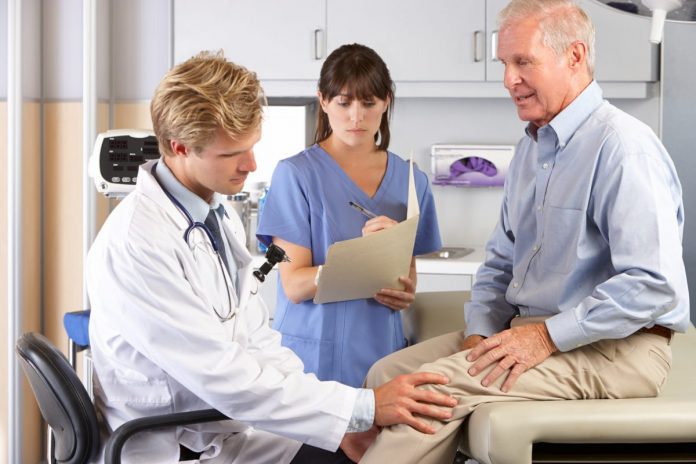Dr Benjamin Ellis, Senior Clinical Policy Adviser at Arthritis Research UK details the importance of good musculoskeletal health in an ageing population
Over the last century, life expectancy has steadily risen at an extraordinary rate. Yet though we live for longer, those additional years are often plagued by ill health. One particular area stands out as affecting quality of life more than any other – musculoskeletal health. Good musculoskeletal health means having the strength and coordination to do all the things we want to do without pain or stiffness. It means not living in fear of falling, and not having fragile bones that can easily break after a minor trip. It means people being able to look after themselves independently, and to keep doing the things they enjoy, such as walking, gardening or dancing. We all want to enjoy good musculoskeletal health. And yet so often it is illusive.
Musculoskeletal conditions are a major threat to good musculoskeletal health. These long-term disorders of the bones, joints, muscles and spine commonly cause pain, stiffness and a loss of mobility and dexterity. Pain and disability from these conditions ruin the quality of life, robbing people of their independence and impairing their ability to participate in family, social and working life.
Musculoskeletal conditions fall into 3 groups, all of which are more common in older people. Conditions of musculoskeletal pain make up the first group, which includes osteoarthritis and back pain. Together these affect more than a quarter of people aged over 45 years. A second group is an osteoporosis – weakened bone. Though osteoporosis is a painless condition, a minor trip or fall can result in a painful and disabling fragility fracture. Rarer conditions where the immune system attacks the body’s tissues make up a third group which includes diseases such as rheumatoid arthritis.
Musculoskeletal conditions are an important component of multi-morbidity in older people. Many of the risk factors are similar to other long-term conditions such as diabetes, heart disease and dementia. For example, obese people are at least twice as likely to develop osteoarthritis of the knee, and obesity is an important risk factor for developing back pain. People who are physically inactive are more likely to develop musculoskeletal problems. Smoking is associated with rheumatoid arthritis, osteoporosis and back pain. People with musculoskeletal conditions such as osteoarthritis are less physically active – pain can limit people’s ability to take the exercise they need to improve their health overall.
Mental health can also suffer because of these conditions. Nearly a quarter of older people with osteoarthritis report depressed mood and 1 in 6 people with rheumatoid arthritis has major depression. Nearly 7 out of 10 people report depressive symptoms when their arthritis pain is at its worst. Psychological distress and depression can also worsen pain, and make it harder for people to cope with their symptoms.
There is a huge impact from musculoskeletal conditions on health and care services, as well as on the wider economy. Each year in the UK, 1 in 5 of the population consults their general practitioner about a musculoskeletal health problem. The direct costs of healthcare for these conditions make up the fourth-largest disease area, after cancer, cardiovascular disease and mental health. Substantial social care costs are attributable to loss of independence because of musculoskeletal conditions, for example, due to the progressive pain and immobility of osteoarthritis, or the sudden, devastating impact of a fragility fracture: only half of those surviving a hip fracture are fully independent a year on. Musculoskeletal conditions can also be a major barrier to workplace participation. Along with mental health problems, they are the leading cause of work days lost due to ill health and are a major call on disability benefits. People with osteoarthritis have a lower income than others and retire at a younger age. As statutory retirement ages rise, a higher proportion of the workforce will be affected and the economic impact is expected to rise.
There is a pressing need to challenge the myth that nothing can be done about musculoskeletal health. Something can be done at every age and at every stage. Regardless of age, people can reduce their risk of developing a musculoskeletal condition in the first place, and can substantially improve their symptoms if they have developed a musculoskeletal condition.
Strategies to reduce obesity in the first place will reduce the prevalence of osteoarthritis. But people with osteoarthritis that lose weight can substantially reduce their symptoms and slow progression. The message is similar to physical activity. Many people wrongly believe that exercise causes arthritis and that people with osteoarthritis or back pain should take it easy and avoid using painful joints. The truth is very different. Walking is simple, accessible and safe – reaching 6,000 steps per day protects against disability in people with or at risk of knee osteoarthritis. Even in later life, becoming physically active promotes healthy ageing, for example reducing by a third the chances of developing difficulty walking or having restriction of daily living activities. One study found that older women who exercised regularly were a fifth less likely to be diagnosed with arthritis over a 6 year period. Another found that physically active women (for example, walking, bicycling, using stairs, and gardening) were a third less likely to need a hip replacement over the 11 years of the study.
Many are predicting a massive increase in musculoskeletal conditions in our ageing, increasingly obese and progressively physically inactive society. Yet this is not inevitable. In public messaging about reducing obesity and increasing physical activity, the public health community must raise awareness about the benefits to musculoskeletal health, reducing risk onset of musculoskeletal problems and reducing impact for those with symptoms. When modelling the benefits of interventions to tackle obesity and physical inactivity, policymakers should include a positive impact on musculoskeletal health. Finally, health and care systems should be geared towards supporting people with musculoskeletal conditions to maintain healthy body weight and become more physically active, so that people have the same access to these interventions as to medications or surgery.
Much can be already be done to improve musculoskeletal health, now and for the future. By taking steps now, governments can help make sure that our ageing societies are pain-free and independent, and that people are able to enjoy a good quality of life throughout their older years.
Dr Benjamin Ellis
Senior Clinical Policy Adviser
Arthritis Research UK
Tel: +44 (0)300 790 0400
enquiries@arthritisresearchuk.org











